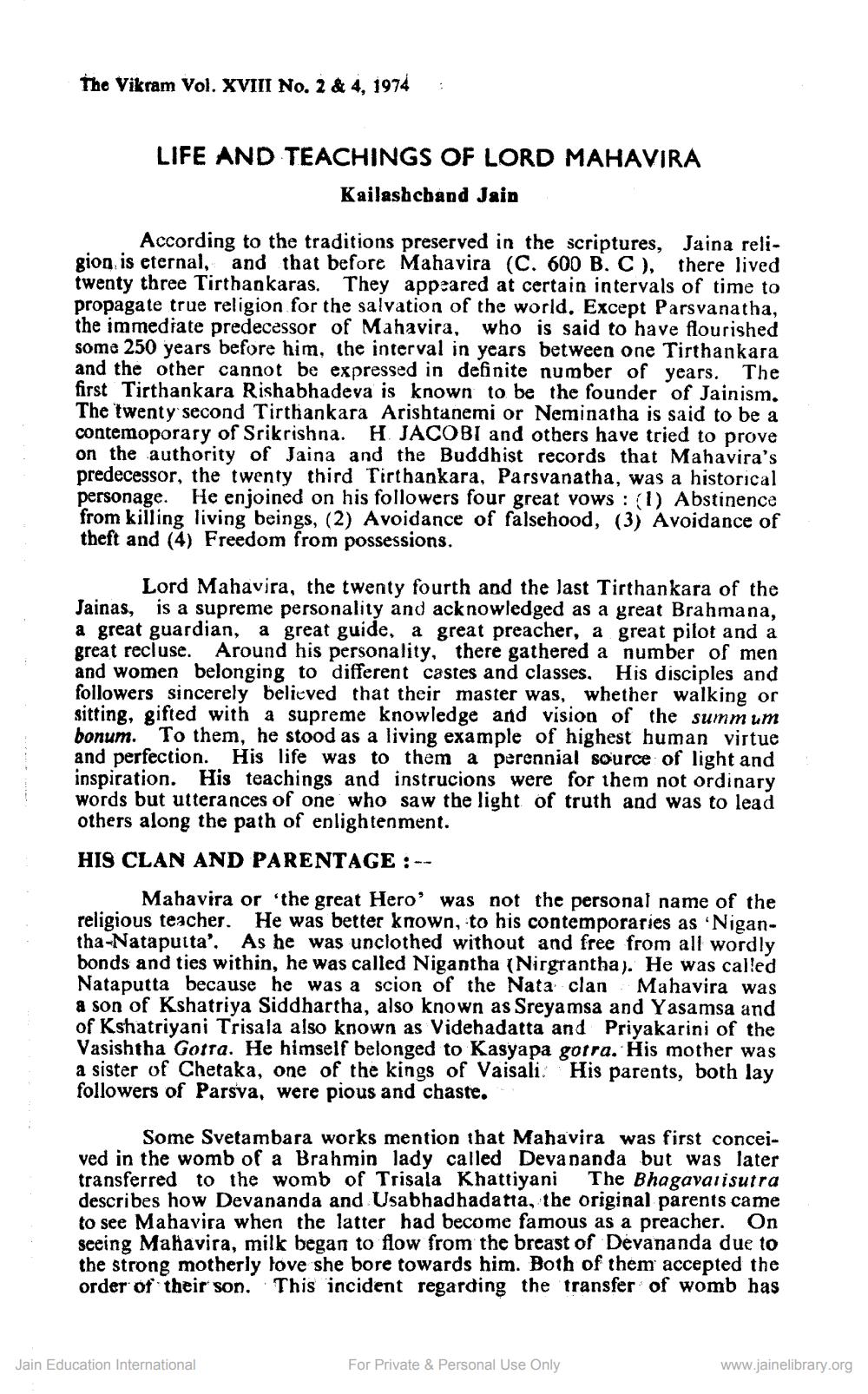________________
The Vikram Vol. XVIII No. 2 & 4, 1974
:
LIFE AND TEACHINGS OF LORD MAHAVIRA
Kailashcband Jain
According to the traditions preserved in the scriptures, Jaina religion, is eternal, and that before Mahavira (C. 600 B. C), there lived twenty three Tirthankaras. They appeared at certain intervals of time to propagate true religion for the salvation of the world. Except Parsvanatha, the immediate predecessor of Mahavira, who is said to have flourished some 250 years before him, the interval in years between one Tirthankara and the other cannot be expressed in definite number of years. The first Tirthankara Rishabhadeva is known to be the founder of Jainism. The twenty second Tirthankara Arishtanemi or Neminatha is said to be a contemoporary of Srikrishna. H. JACOBI and others have tried to prove on the authority of Jaina and the Buddhist records that Mahavira's predecessor, the twenty third Tirthankara, Parsvanatha, was a historical personage. He enjoined on his followers four great vows: (1) Abstinence from killing living beings, (2) Avoidance of falsehood, (3) Avoidance of theft and (4) Freedom from possessions.
Lord Mahavira, the twenty fourth and the last Tirthankara of the Jainas, is a supreme personality and acknowledged as a great Brahmana, a great guardian, a great guide, a great preacher, a great pilot and a great recluse. Around his personality, there gathered a number of men and women belonging to different castes and classes. His disciples and followers sincerely believed that their master was, whether walking or sitting, gifted with a supreme knowledge and vision of the summ um bonum. To them, he stood as a living example of highest human virtue and perfection. His life was to them a perennial source of light and inspiration. His teachings and instrucions were for them not ordinary words but utterances of one who saw the light of truth and was to lead others along the path of enlightenment.
HIS CLAN AND PARENTAGE:--
Mahavira or the great Hero' was not the personal name of the religious teacher. He was better known, to his contemporaries as 'Nigantha-Nataputta'. As he was unclothed without and free from all wordly bonds and ties within, he was called Nigantha (Nirgrantha). He was called Nataputta because he was a scion of the Nata clan Mahavira was a son of Kshatriya Siddhartha, also known as Sreyamsa and Yasamsa and of Kshatriyani Trisala also known as Videhadatta and Priyakarini of the Vasishtha Gora. He himself belonged to Kasyapa gorra. His mother was a sister of Chetaka, one of the kings of Vaisali: His parents, both lay followers of Parsva, were pious and chaste.
Some Svetambara works mention that Mahavira was first conceived in the womb of a Brahmin lady called Devananda but was later transferred to the womb of Trisala Khattiyani The Bhagavalisutra describes how Devananda and Usabhadhadatta, the original parents came to see Mahavira when the latter had become famous as a preacher. On seeing Mahavira, milk began to flow from the breast of Devananda due to the strong motherly love she bore towards him. Both of them accepted the order of their son. This incident regarding the transfer of womb has
Jain Education International
For Private & Personal Use Only
www.jainelibrary.org




